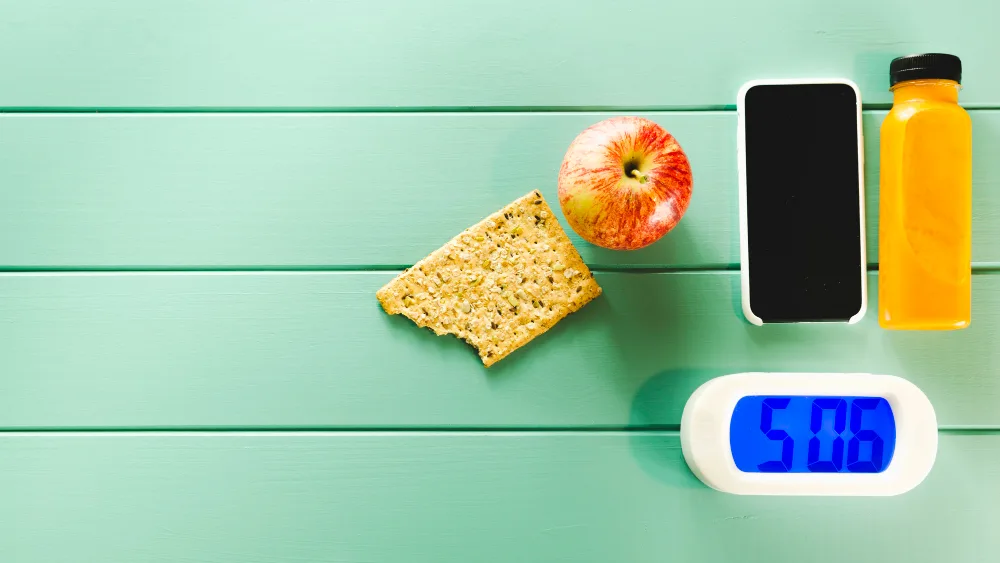Healthy Options to Keep Your Blood Sugar Stable
Finding the right mini‑meals between breakfast, lunch, and dinner can feel tricky when you live with diabetes. Reach for the wrong nibble and your glucose may spike; skip snacks entirely and you risk a blood‑sugar crash that leads to overeating later on. Mastering Smart Snacking for Diabetes means stocking options that taste great, travel well, and—most importantly—release glucose slowly so your energy stays level all day long.
This comprehensive guide (≈1 700 words) breaks down why strategic snacking matters, how to time bites around medication or exercise, and which ingredients balance carbs, protein, and healthy fat for optimal metabolic impact. You’ll get 20 snack ideas—many pulled straight from the Bariatric Air Fryer Cookbook—plus easy prep hacks, grocery shortcuts, and both internal and external resources for deeper learning.
Why Smart Snacking Supports Glucose Control
Well‑planned snacks offer three major advantages for people with diabetes:
- Prevent Hypoglycemia – Small, balanced bites between meals can stop blood‑sugar dips caused by insulin or other glucose‑lowering meds.
- Curb Overeating – Taming hunger with nutrient‑dense snacks reduces the urge to raid the pantry before dinner.
- Provide Steady Energy – Snacks that pair slow‑digesting carbs with protein and healthy fat release glucose gradually, smoothing out highs and lows.
The American Diabetes Association notes that snacks containing 15–20 g of carbs paired with protein are often ideal for maintaining stable blood sugar through the afternoon.
The Anatomy of a Smart Snack
| Component | Why It Matters | Sleeve‑Sized Examples |
|---|---|---|
| Lean Protein | Slows carb absorption, supports muscle repair | 1 oz turkey, 2 Tbsp hummus, ¾ cup Greek yogurt |
| Fiber‑Rich or Low‑GI Carb | Provides slow fuel, helps you feel full | ½ apple, ½ cup berries, 3 Tbsp oats |
| Healthy Fat | Extends satiety, aids vitamin absorption | 1 tsp almond butter, 6 almonds, ¼ avocado |
| Volume from Produce | Adds crunch & micronutrients for minimal carbs | Cucumber rounds, bell‑pepper strips |
For more on balancing macros without a food scale, visit our post on Mastering Portion Control; the same palm‑size visuals work wonders for snacks.
Sugar & Sodium Watchouts
- Steer clear of “low‑fat” packaged snacks—they often compensate with added sugar.
- Opt for unsalted nuts; flavored varieties may hide 250 mg sodium per ounce.
20 Smart Snacking Ideas (Most in <10 Minutes)
Below, you’ll find travel‑ready combos organized by carbohydrate load and prep method. Carb counts reflect net grams (total carbs minus fiber).
Low‑Carb (<8 g Net)
- Turkey‑Wrapped Avocado Sticks – 2 slices deli turkey around ¼ avocado (5 g net C, 11 g P).
- Everything‑Seasoned Cottage Cheese – ½ cup low‑fat cottage cheese + pinch everything‑bagel spice (6 g net C, 14 g P).
- Air‑Fried Parmesan Zucchini Fries (from Bariatric Air Fryer Cookbook, p 42) – ½ cup portion (4 g net C, 5 g P).
- Smoked Salmon Cucumber Bites – 1 oz salmon on 6 cucumber rounds (3 g net C, 7 g P).
- Hard‑Boiled Egg & Mini Bell Pepper – Slice egg, tuck inside pepper halves (2 g net C, 6 g P).
Moderate Carb (8–15 g Net)
- Apple Nachos – ½ small apple sliced, drizzled with 1 Tbsp peanut‑butter powder slurry (12 g net C, 5 g P).
- Berry Yogurt Parfait – ½ cup plain Greek yogurt + ¼ cup berries + dash cinnamon (10 g net C, 12 g P).
- Protein Hot Cocoa – 8 oz unsweetened almond milk, 1 Tbsp cocoa, ½ scoop chocolate whey (9 g net C, 15 g P).
- Air‑Fried Chickpea Crunchers – ¼ cup drained chickpeas tossed with paprika, air‑fried 12 min (14 g net C, 5 g P).
- PB&J Celery Sticks – 2 celery ribs spread with 1 Tbsp natural PB + 1 tsp chia‑berry mash (11 g net C, 4 g P).
High‑Fiber (<18 g Net but >5 g Fiber)
- Oat & Flax Energy Bites (see Gastric Sleeve Recipes post) – 1 bite (17 g net C, 6 g fiber, 6 g P).
- Trail Mix Lite – 1 Tbsp almonds + 1 Tbsp pumpkin seeds + 1 Tbsp unsweetened coconut chips (8 g net C, 3 g fiber, 4 g P).
- High‑Fiber Wrap Pinwheels – ½ high‑fiber tortilla spread with 1 oz turkey & 1 Tbsp light cream cheese, rolled & sliced (15 g net C, 10 g fiber, 10 g P).
Quick Heat‑and‑Eat
- Mini Egg‑Ricotta Muffin (air fryer, 320 °F, 6 min) – 1 egg + 2 Tbsp ricotta (2 g net C, 9 g P).
- Parmesan‑Herb Chicken Bites (375 °F, 8 min) – 2 oz chicken cubes dusted with parmesan (1 g net C, 14 g P).
- Tofu “Crouton” Squares – 2 oz tofu tossed in soy‑ginger marinade, air‑fried 10 min (3 g net C, 10 g P).
Satisfy‑the‑Sweet‑Tooth
- Cinnamon Apple Chips (Diverticulitis Cookbook, p 39) – ½ cup chips (14 g net C, 3 g fiber).
- Chocolate‑Avocado Pudding – Blend ¼ avocado, 1 Tbsp cocoa, 1 packet stevia, splash almond milk (9 g net C, 2 g fiber, 2 g P).
- Frozen Berry “Sorbet” – Pulse ½ cup frozen strawberries, 2 Tbsp Greek yogurt, stevia (7 g net C, 5 g P).
- Ricotta‑Berry Stuffed Dates – 1 Medjool date halved, filled with 1 tsp ricotta + 2 blueberries (13 g net C, 1 g P).
For crunchy, air‑fried versions of several snacks, explore Air Fryer Magic, which details temperature and shake‑time charts for veggies, legumes, and fruit.
Timing Your Snacks Around Meds & Workouts
| Scenario | Best Snack Window | Suggested Combo |
| Rapid‑Acting Insulin | 1–1½ hrs after injection | Apple nachos or yogurt parfait (moderate carbs + protein) |
| Pre‑Workout | 30 min before exercise | Protein hot cocoa or trail mix lite (fuel + amino acids) |
| Post‑Workout | Within 45 min after | Mini egg‑ricotta muffin (quick protein) + cucumber water |
| Bedtime Dip Risk | 1 hr before sleep if on nighttime insulin | PB&J celery sticks or cottage cheese bowl (slow protein) |
For more med‑timing insights, read our post on Best Meal Timing for Diabetes; it pairs each insulin type with ideal snack macros.
Building a Snack‑Optimized Pantry
Proteins
- Whey isolate single‑serve packets
- Low‑fat cottage cheese cups
- Tuna pouches (no drain)
Low‑GI Carbs
- Unsweetened applesauce cups
- Quick oats, flaxseed meal
- High‑fiber tortillas (≥10 g fiber)
Healthy Fats
- Almond butter squeeze packs
- Roasted pumpkin seeds
- Avocado oil spray (for air frying)
Flavor Extras
- Everything‑bagel seasoning
- Sugar‑free buffalo sauce
- Cinnamon, cocoa powder
Want detailed cost breakdowns? See Diabetic Meal Planning on a Budget for bulk‑buy tips on protein powders, seeds, and low‑carb flours.
Meal‑Prep Hacks: Snack Edition
- Protein Pop Ice‑Tray – Blend 2 protein shakes; freeze in silicone mini‑cubes for instant slushies.
- Veggie Grab Bags – Pre‑slice 3 cucumbers, 3 bell peppers; pack ½‑cup snack bags.
- Portion Trail Mix – Use a mini cupcake pan to measure 2‑Tbsp servings before storing in a jar.
- Air‑Fry in Batches – Chickpeas, zucchini fries, and tofu squares cook simultaneously on separate racks; refrigerate 3–4 days.
Need more freezer‑friendly tricks? Smart Carb Swaps for a Diabetes-Friendly Diet includes a printable batch‑cook planner.
Eating Out: Convenience‑Store & Drive‑Thru Picks
While home‑prepped snacks rule, life happens. Here’s what to grab in a pinch:
- Convenience Store: Individual cheese stick + small apple (check carb size), or 2 HB eggs + sugar‑free iced tea.
- Coffee Shop: Tall unsweetened cold brew + 1 protein snack box (omit sugary dressing).
- Fast‑Food Drive‑Thru: Grilled chicken sandwich—discard bun, keep lettuce + tomato; pair with side salad.
The CDC offers additional survival tips for navigating fast‑food menus with diabetes.
Supplements That Support Snack Strategy
- Fiber Gummies/Powder – Use when veggie intake drops below 3 cups daily (choose sugar‑free).
- Probiotic Capsules – Maintain gut flora to enhance carb metabolism; look for 10 B CFU multi‑strain.
- Omega‑3 Fish Oil – Counteracts inflammation; talk to your doctor for dosage.
FAQs About Smart Snacking for Diabetes
How often should I snack? Most adults do well with one mid‑morning and one mid‑afternoon snack; adjust per your glucose readings and hunger cues.
What’s the ideal carb count? 10–15 g net carbs is common; those on mealtime insulin or athletes may aim for 20 g. Test and tweak.
Are air‑fried snacks “free foods”? No—log macros and watch sodium. Air frying reduces fat, not calories.
Can I drink with snacks? Hydrate between bites, but avoid chugging water right after bariatric surgery to prevent pouch discomfort.
Key Takeaways & Next Steps
- Smart snacks balance protein, fiber, and healthy fat to stabilize blood sugar and curb overeating.
- Air fryers elevate snack texture with minimal oil—check the Bariatric Air Fryer Cookbook for dozens more ideas.
- Pre‑portion, batch cook, and keep a macro‑friendly pantry to avoid impulse carb bombs.
Ready to expand your arsenal beyond these 20 bites? The Bariatric Air Fryer Cookbook packs 100+ snack, appetizer, and mini‑meal recipes—each with carb counts, portion icons, and stage‑by‑stage modifications. Stay crispy, stay steady.


Leave a Reply